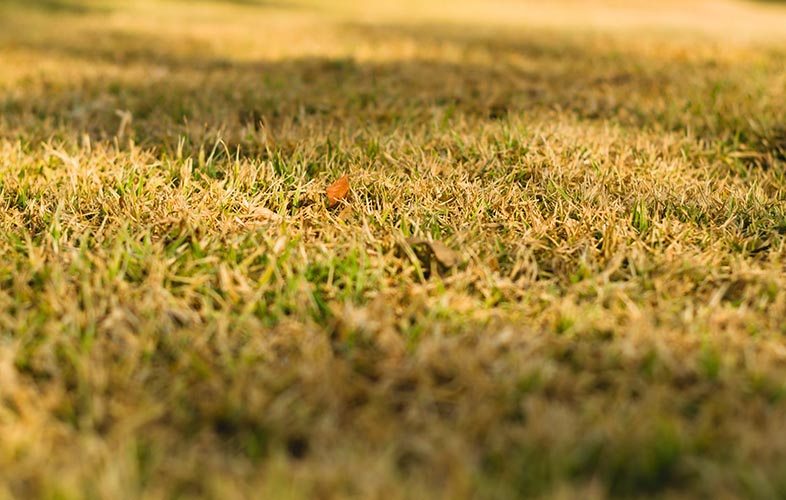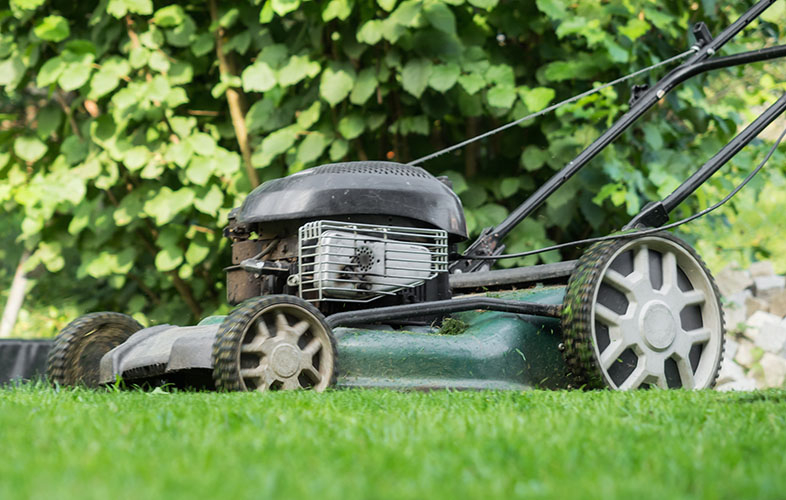Drought can put severe stress on your lawn and make it more susceptible to insect damage and weed invasion. Fighting drought to keep your lawn healthy can be tough, but with the proper knowledge, techniques and help from TruGreen® experts you can maintain a vibrant, lush lawn you can be proud of.
What is drought stress?
- Changes in hue. Your lawn may change color from bright green to dull gray or blue-green.
- Footprints. Footprints (or lawn mower tracks) will stay visible in grasses that are too tired to spring upright after they’ve been pushed down.
- Wilting. Grass blades will roll or fold as they lose water content, wilting visibly in the heat.
- Changes in color. As drought stress becomes more severe, your lawn may do more than lose its bright green hue. If you’re asking, “How can I get my grass green?” you may already be noticing shades of yellow or tan. Once you see tan coloration, your lawn is in a state of drought-induced dormancy—a last-ditch attempt to survive the dry heat by shutting down.
Preventing drought stress
The best way to beat drought stress is to stop it from happening in the first place. Here are some steps you can take to help ensure your lawn stays healthy in dry conditions:
Keep your grass longerTurf that stands about 3.5 to 4 inches tall helps shade the soil and conserve its water. Mow lawns higher for the summer and on a frequent basis so that no more than ⅓ of the grass blade is cut when mowing.
Sharpen mower bladesA clean cut blade of grass requires less energy to heal, allowing grass to conserve energy.
Get a head startCaring for your lawn in the fall and early spring gives you a head start on a healthy green lawn for summer.
How to combat drought stress
If the drought stress issue is passed the point of prevention, you’ll need to focus on fixing the problem. Here are some tips for dealing with drought stress:
Don’t mow a healthy lawn too shortIf you’re just beginning to see signs of stress, make sure you’re mowing high enough for your grasses’ recommended growth. Mowing too close can result in a shallow root system, increasing chances of drought stress. It’s an easy problem to fix if you catch it early.
Minimize damageDon’t mow drought-stressed grass, and walk on it as little as possible. The more you limit traffic, the less wear and tear you’ll inflict on your already damaged lawn. Avoid the temptation to mow off tall weeds that may be outcompeting your turf until the grass has returned to health.
WaterIf your lawn is wilting or showing discoloration, water now. Water your lawn 2-3 times a week, early in the morning to minimize evaporation. Don’t water in the evening or overnight, as this increases the likelihood of attracting disease or pests. If your lawn has not begun to go dormant, you should see green coloration with regular watering.
If the grasses are already going dormant, yellow or tan coloration will remain. In that case, water lightly and regularly—at least ½ inch of water every 7 to 14 days. Light watering will help keep plants alive and assist recovery later in the plants’ life cycle.Have thatch professionally removed
If you notice drought signs, check for thatch—a layer of decaying stems and roots that can build up over time between the surface and the soil beneath.
Heavy thatch can make your grasses more prone to drought stress when grass roots are in thatch instead of fertile soil. Thatch absorbs moisture but dries quickly, leaving grasses prone to drying even after rain. Consult an expert to discuss the proper time and method of thatch removal to ensure a healthier lawn next season.
TruGreen’s targeted solutions include treatments specially designed to treat drought stress. When you sign up for a TruGreen lawn plan, a TruExpertSM Certified Specialist conducts a Healthy Lawn Analysis®. If this examination reveals your yard is suffering from drought, your plan will be further tailored to manage the effects of moisture deprivation.
With TruGreen’s Healthy Lawn Guarantee® on your side, you’ll know TruGreen specialists will work with you to create an irrigation plan to help your grass thrive—even in dry conditions. To learn more about the TruGreen Healthy Lawn Guarantee and tailored plan options, call 866.688.6722 or visit TruGreen.com.













